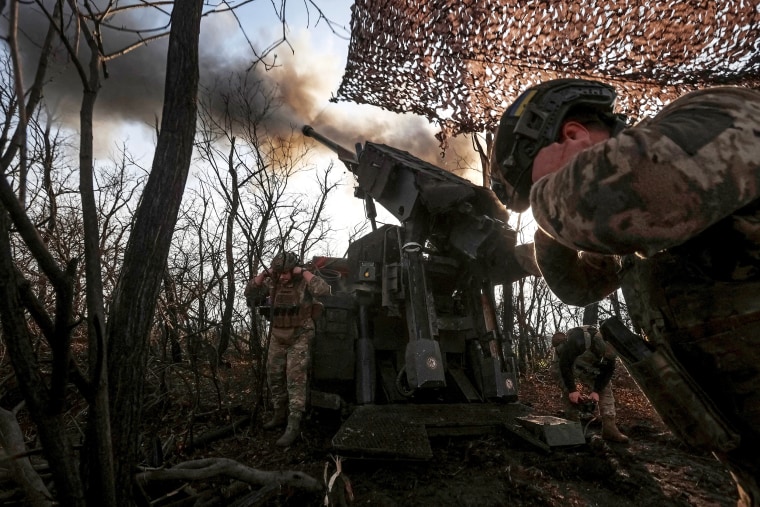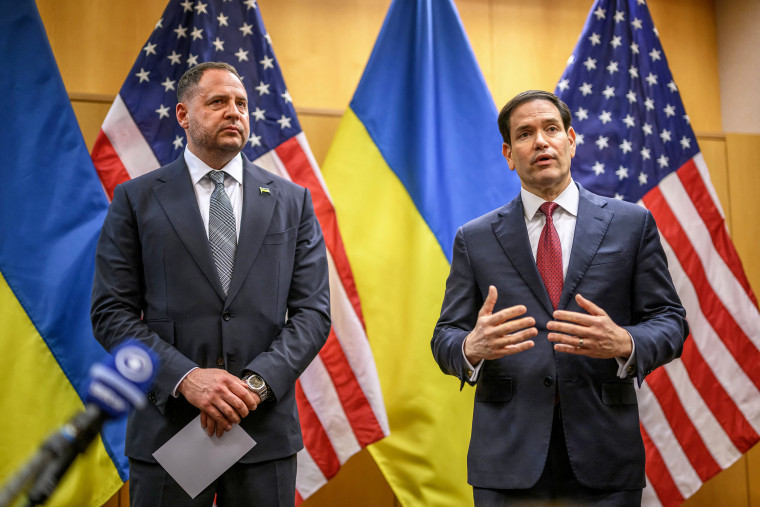In a meeting with Ukrainian officials in Kyiv last week, U.S. Army Secretary Dan Driscoll delivered a grim assessment.
Driscoll told his counterparts their troops faced a dire situation on the battlefield and would suffer an imminent defeat against Russian forces, two sources with knowledge of the matter told NBC News.
The Russians were ramping up the scale and pace of their aerial attacks, and they had the ability to fight on indefinitely, Driscoll told them, according to the sources. The situation for Ukraine would only get worse over time, he continued, and it was better to negotiate a peace settlement now rather than end up in an even weaker position in the future.
And there was more bad news. The U.S. delegation also said America’s defense industry could not keep supplying Ukraine with the weapons and air defenses at the rate needed to protect the country’s infrastructure and population, the sources said.
Driscoll’s message came after he had presented a U.S.-backed peace plan that Kyiv officials viewed as a capitulation to Moscow, according to the two sources.
“The message was basically — you are losing,” one of the sources said, “and you need to accept the deal.”
The meeting between Driscoll and the Ukrainians was part of an effort by some Trump administration officials to press the Ukrainians to accept the new U.S.-backed peace proposal without delay, even though it embraced Russia’s maximalist demands and required painful concessions from Kyiv’s government, multiple current and former Western officials said.
Ukraine politely declined to sign on to the peace plan as it was presented, and the proposal has been heavily revised since the discussions between Driscoll and Ukrainian officials last week.
The meeting was just the latest example of a long-running rift inside the Trump administration over how to end the war in Ukraine. The split features a looming potential political rivalry between two former senators and potential presidential hopefuls positioning themselves for 2028: Vice President JD Vance and Secretary of State Marco Rubio.
One camp, including Vance, special envoy Steve Witkoff and other officials, views Ukraine as the primary obstacle to peace and favors using U.S. leverage to force Kyiv to make major compromises, according to multiple current and former officials.
The other camp, represented by Rubio and other officials, sees Russia as the culprit for having launched an unprovoked invasion of its neighbor and says Moscow will relent only if it pays a price for its aggression through sanctions and other pressure.
With his deputies vying for his attention along with Republican lawmakers and European leaders, President Donald Trump has veered back and forth on how to resolve the conflict.
“It was clear for some time that there was a divide, but we’ve never seen it in action publicly quite the way we have in the last few days,” said a former senior U.S. diplomat with experience in Eastern Europe.

Reached for comment Tuesday, the White House referred to a social media post in which Trump said the original peace plan has been “fine-tuned, with additional input from both sides, and there are only a few remaining points of disagreement.”
“I look forward to hopefully meeting with President Zelenskyy and President Putin soon, but ONLY when the deal to end this War is FINAL or, in its final stages,” Trump added in the post.
A State Department spokesperson said, “President Trump’s entire team, including Secretary Rubio, Special Envoy Witkoff, Secretary Driscoll, and many others, are working in lockstep, as they have been for 10 months, to bring an end to the senseless and destructive war.”
The Ukrainian Embassy in Washington did not respond to a request for comment.
Grave doubts
The frenetic diplomacy began last week after a purported 28-point U.S. peace plan leaked to the media.
The plan was the product of discussions in Miami between Russian President Vladimir Putin’s envoy, Kirill Dmitriev, and his U.S. counterpart, Witkoff, according to two sources with knowledge of the meeting.
White House officials told reporters it was an American proposal, even though the document embraced Russia’s repeated demands to force Ukraine to cede territory it controls, scale back its military and give up ever joining the NATO alliance. Some elements of the plan contradicted the Trump administration’s previously stated positions, including language that implied U.S. military forces would be barred from Poland.
Republican and Democratic senators said Rubio had told them it was a plan drafted by the Russians. But Rubio later said their account was false, and he and the White House later insisted it was a U.S. proposal with Russian and Ukrainian “input.”
In an unusual move, the White House chose Driscoll, the Army secretary, to brief the Ukrainians on the proposal, instead of a senior diplomat. Driscoll, an old Yale Law School classmate of Vance’s, was headed to Ukraine on a previously scheduled visit to discuss drone technology, NBC News previously reported.
Taken aback by the peace proposal’s terms, Ukrainian President Volodymyr Zelenskyy expressed grave doubts but stopped short of vetoing the plan, saying his government was ready to hold diplomatic discussions.
Rubio used cautious language about the plan after it leaked, posting on X that peace would “require both sides to agree to difficult but necessary concessions” and that the United States would “continue to develop a list of potential ideas for ending this war.”
Trump, meanwhile, ramped up pressure on Ukraine, telling reporters that Zelenskyy’s choice was to accept a peace deal or “continue to fight his little heart out.”

Rubio flew to Geneva over the weekend, and after talks with the Ukrainians and appeals from European diplomats, the most problematic provisions for Ukraine were removed or revised, according to multiple Western officials and sources with knowledge of the matter.
Instead of the take-it-or-leave-it tone White House officials used about the peace plan earlier, Rubio portrayed the discussions as fluid and said the plan was rapidly evolving. “This is a living, breathing document. Every day with input it changes,” he told reporters in Geneva.
By Tuesday, the Ukrainians had struck a positive note, expressing optimism about what was now a 19-point plan under discussion.
“Our delegations reached a common understanding on the core terms of the agreement discussed in Geneva,” Rustem Umerov, secretary of Ukraine’s national security and defense council, wrote on social media. And he raised the prospect of a possible visit to Washington by Zelenskyy to seal the deal.
Driscoll traveled on to Abu Dhabi, where he held talks with a Russian delegation Monday and Tuesday, officials said.
With the peace plan revised from its original form, it resembled previous proposals that Russia has rebuffed.
Lavrov, the Russian foreign minister, who had “welcomed” the initial draft from last week, suggested Tuesday that the Kremlin might reject what was now on the table. Lavrov cited discussions in August between Trump and Putin at a summit in Anchorage, Alaska, saying the latest draft proposal appeared to contradict the understanding reached in those talks.
“Some forces want to jeopardize efforts by Donald Trump and to change the peace plan,” Lavrov said, adding, “If the ‘spirit’ of Anchorage will be wiped out from this plan, then it’s going to be a whole other story.”
As in previous U.S. diplomatic efforts, one faction in the administration had tried to champion a proposal that favored Russia and other officials had pushed back, with the backing of European governments and senior Republicans in Congress, according to Western officials, former U.S. diplomats and experts.
“If the split lasts, it’s going to be very difficult to pursue a coherent policy,” said William Taylor, a former ambassador to Ukraine who is now a fellow at the Atlantic Council think tank.



